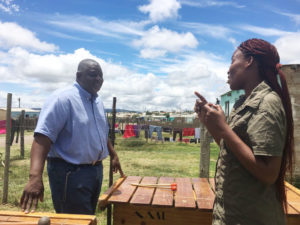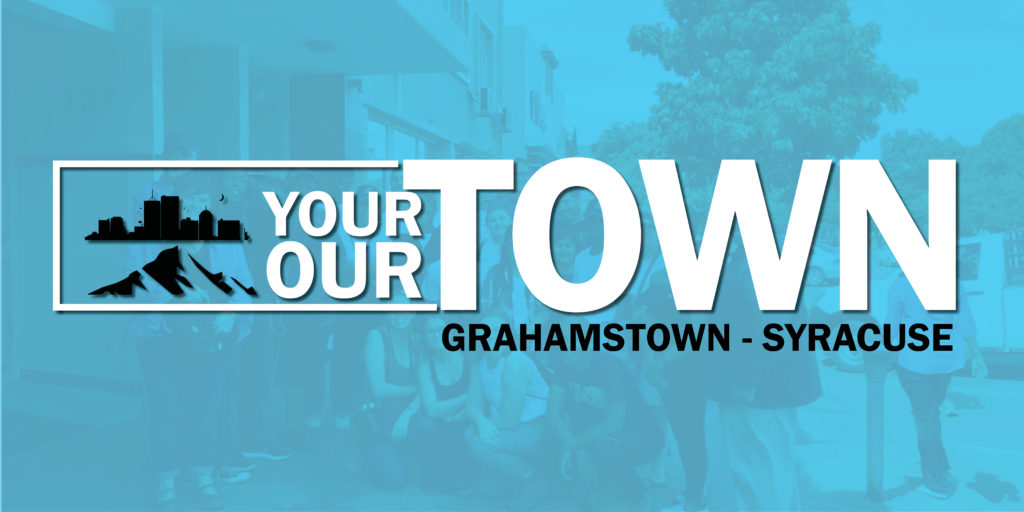Your Town, Our Town: Black musicians share stories
By Reggie Seigler

Music columnist travels from Syracuse to South Africa to learn black musicians on each continent share strikingly similar experiences
As a longtime local musician and appreciator of live music, I have recognized that there is a large disparity between the presentation of local artists of color and white artists at many of the live music events hosted in the city of Syracuse. This statement might be a surprise for some, especially if they haven’t looked, but for many others, it will seem to be just a rehash of old news.
Our beloved Syracuse has been identified as a city where poverty and disparity exist in high numbers and has been well studied and documented. In 2016, the United States Census Bureau reported that Syracuse was the 13th poorest city in the US. The ranking surpasses even cities like Detroit and Buffalo. An even more depressing statistic pulled from a recent study done by Paul Jargowsky of Rutgers University reveals that Syracuse is the No. 1 city in America for “concentrated poverty” among blacks and Hispanics. Obviously, these are not statistics we are proud of, but we can’t ignore them.
The population of Syracuse is about 145,000 people. Of those, about 64,000 residents consider themselves non-white, (approximately 44 percent). So, this beast of concentrated poverty that we are speaking about negatively affects a lot of people, and it is continually growing as it is being well fed on a steady diet of neglect for people of color, which includes the disregard for opportunities for creative artists of color as well.
After the holidays, I traveled to Grahamstown, with a school group, which was a repeat endeavor for professor Steve Davis of Newhouse. He took a group there before in 2010-11. On that mission, they pursued dialogue with students and professors from Rhodes University and the people of the Grahamstown community. That effort centered on the idea that people are more similar than dissimilar, regardless of where they live.
The professor’s mission for this trip was essentially the same as it had been before: to show how people are the same everywhere. This time it carried a sub-theme related to music and art. Being one who has an interest in the equitable distribution of economic opportunities in Syracuse, I used the opportunity to learn if opportunities were equitably shared with black artists in Grahamstown. I wanted to know if things would be the same as they are here, as I suspected, or would I find them to be different? I also wanted to know what was being done to change things.
Grahamstown provided a good backdrop to make the observation. Like Syracuse, its largest employer is a wealthy university sitting high on a hillside overlooking a population made up of about 89 percent blacks and other people of color and has a poverty rate estimated at about 40 percent. Unemployment for blacks there is high, and although some are working, most are likely to be employed in low-paying retail or service-industry jobs. Some others work independently but earn as little as 100 rand a day, about $8 to $10 in U.S. currency.
Grahamstown has a few nice restaurants and bars, which are mostly situated around the Rhodes campus. They could provide nice venues for musicians and other performing artists to play. However, the establishments cater largely to the white middle class and the faculty and students of the university. That dictates any entertainment they might present, which doesn’t include many artists of color.
The city is also the home of the National Arts Festival. The NAF runs for 11 days annually in late June into July and is the largest festival of any kind on the African continent. It boasts about 600 performances and transforms all of Grahamstown’s auditoriums, bars, clubs, restaurants and open spaces into makeshift performance venues throughout its run. The number of people drawn to the NAF nearly doubles the population of Grahamstown, bringing in people from all over the world. Every available hotel and dormitory room in the area is filled with media, entertainers and festivalgoers.
There is an educational program in Grahamstown called Inkululeko. It is a nonprofit organization dedicated to helping Xhosa children become higher achievers in school. It was founded by Jason Torreano, who attended Rhodes University during an exchange program and now runs the nonprofit half-time from America and half-time in Grahamstown. Jason is very well-connected in the area and was able to put us in touch with the people we needed to connect with to tell our stories. Madoda Mkalipi works for Jason at Inkululeko and acted as one of our guides during our stay. He spoke with me briefly about the festival and the few opportunities it presented for musicians in Grahamstown.
“All of the black musicians in Grahamstown want to play at the National Arts Festival,” Madoda said. “Sometimes they can get an opportunity to play, but it’s not every year and it’s mostly at locations and times where the exposure is minimal.” Madoda graduated from Rhodes University. He is not a musician himself, but he knew and introduced us to Zandile Kila (pronounced Zon-de-lah Keelah) and Richard Nzwana, who were.
Zandile has a formal music education and teaches kids to play the piano. She plays the tenor instrument in a marimba ensemble called Laphumilanga, which means the sun comes out or sunrise. The group was founded by Richard Nzwana in 2010. They can perform as a small group of four pieces or as a large group of up to 13 musicians. Five of their musicians are blind, including Richard himself. Zandile is sighted.
I asked Zandile about the festival and the gigs that they get and whether she thought that they got as many as some of the white groups in the area.
“There are opportunities for us, namely from Rhodes,” she began, “but there aren’t as many as we would like. We could go from two gigs a month to nothing for four months then one or two. We are lucky we get called from the Department of Arts and Culture for performances and referred by the department for other performances. The difference between groups with a more predominately white presence than ours is there are more venues actively booking them.” She said that her group was more likely to be only a “feature in those venues,” occasionally. Zandile had a couple of opportunities to perform at the NAF, once in 2011 with the University of Fort Hare’s marimba ensemble, and again in 2017 with Laphumilanga.
Zandlile also builds marimbas and calabash instruments that she sells to earn extra money.
I also met Gareth Walwyn and Shiloh Marsh, who live in Grahamstown. They were a couple who had met through a mutual friend at Rhodes University. Shiloh was a classical singer and teacher who was born there and had been on a tour of foreign places when Gareth began hearing about her.
“She had a reputation,” he said, as they both then chuckled and shared a look — for her as if she’d heard this little joke one too many times; for him as if he knew the time were drawing near for it to be retired for good.
The two of them have a couple of compelling common interests: music and teaching. They said that those interests had been driving their lives and shaping their purpose for a long time. Seven years ago, they decided to use their synergy to form an NGO (non-governmental organization) through which they could fulfill their purpose together.
The organization is called Access Music Project (AMP). They use AMP to teach music to Xhosa children. The project is housed at the Joza Youth Hub in a place called “The Location,” or “Elokishini” (pronounced El-o-ka-sheen), by the Xhosa people who live there. It is situated in the township, which is just outside of Grahamstown’s city proper. To get a feel for The Location, you must first understand how it was created and how the people who live there are oppressed.
South Africa is just 26 years beyond the fall of the devastating system of oppression, segregation and corruption known as apartheid. The system of government closely resembled “Jim Crow” in America. It held a discriminatory system of laws that prohibited blacks in South Africa, many of whom were Xhosa, from participating in the political process. And through its laws of segregation, it relegated their living spaces to the most undesirable areas with undeveloped infrastructure and little to no services, such as fire and police protection, trash collection, etc. The discriminating laws also limited their employment opportunities and funding for schools and other services. There were even laws making it ‘unconstitutional’ for people of black and white races to date or marry.
Apartheid in South Africa was not by happenstance. It was deliberately designed to preempt the black majority from building power over the white minority, and also to ensure continued white existence and rule in the country. The laws have now been changed, but many musicians, such as Francois Mentoor, say things still seem the same today. Political corruption, misuse and inequitable sharing of government resources still severely devastate and oppress the people.
“Elokishini,” Francois said, “is one of those places that black people were allowed to live during apartheid.” Many are still there now living in overcrowded corrugated tin shanties with interior walls formed from a mixture of mud and donkey poop. Most do not have running water because the government has not fully extended the infrastructure, so they rely on water that is brought in and stored in tanks that are propped up beside their houses. Homes like this number in the thousands and are strewn about over square miles and miles of government lands.
To be continued…
This is part one of a three part story series.
This content was originally published in The Stand (online) 1 February 2018.
PART TWO: ‘Hard work and homework’
http://www.grocotts.co.za/2018/02/25/hard-work-and-homework/
ALSO READ: ‘Hopefully lessons from one of ‘those’ places’:
http://www.grocotts.co.za/2018/02/13/your-town-our-town-media-exchange/


